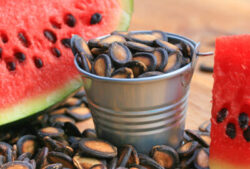Panama Berry (Muntingia Calabura): All You Need To Know This Fruit
What Is Panama Berry?
Panama Berry, also known as Muntingia calabura, is a small fruit tree native to South and Central America. The tree is widely grown for its edible fruit, which is packed with numerous health benefits. The fruit is small, red, and has a unique flavor that is a combination of sweet and sour.
Panama Berry is rich in antioxidants, vitamins, and minerals that make it a superfood. The fruit is used in traditional medicine to treat various ailments, including fever, cold, and digestive problems. Additionally, the leaves and bark of the tree have been used in traditional medicine to treat a variety of illnesses.
In this article, we will explore the origins and distribution of Panama Berry, its nutritional value, health benefits, culinary uses, growing and harvesting tips, potential side effects, and how to add it to your diet for improved health.
Origin and Distribution of Panama Berry
Panama Berry, or Muntingia calabura, is a fruit tree that is native to South and Central America. The tree is believed to have originated in Mexico and is now found in many tropical regions around the world.
Panama Berry trees are commonly found in countries such as Brazil, Colombia, Ecuador, Peru, Venezuela, and throughout the Caribbean islands. The tree has also been introduced to many other tropical regions, including Southeast Asia, Africa, and the Pacific Islands.
The tree is known by various names, depending on the region. For instance, in the Philippines, it is called “aratilis,” while in Indonesia, it is called “kerukup siam.”
Panama Berry trees grow best in warm, humid environments with consistent rainfall. They can tolerate a range of soils, including sandy and clay soils, but do best in well-draining soils. The tree is a fast grower and can reach a height of up to 30 feet. It produces fruit year-round, making it an important food source in many tropical regions.
Today, Panama Berry is cultivated commercially for its edible fruit and is also grown as an ornamental tree in many parts of the world.
Also Read: How to make a Trellis for blackberries
Nutritional Value of Panama Berry: A Powerhouse of Antioxidants
Panama Berry is a nutrient-dense fruit that is packed with antioxidants, vitamins, and minerals. Here are some of the key nutrients found in Panama Berry:
- Antioxidants: Panama Berry is a rich source of antioxidants, including polyphenols, flavonoids, and carotenoids. These compounds help to protect the body from oxidative stress and may help reduce the risk of chronic diseases.
- Vitamins: Panama Berry is an excellent source of vitamin C, with a 100-gram serving providing over 150% of the recommended daily intake. The fruit is also a good source of vitamin A and several B vitamins, including thiamin, riboflavin, and niacin.
- Minerals: Panama Berry is a good source of minerals, including calcium, potassium, and iron. It also contains smaller amounts of zinc, magnesium, and phosphorus.
- Fiber: Panama Berry is a good source of dietary fiber, which helps to promote digestive health and may also help reduce the risk of certain chronic diseases.
Overall, the nutritional profile of Panama Berry makes it a great addition to a healthy diet. It is low in calories, high in fiber and antioxidants, and provides a variety of vitamins and minerals.
Health Benefits of Panama Berry: Boosting Immunity and More
Panama Berry is packed with nutrients that provide numerous health benefits. Here are some of the key health benefits associated with consuming Panama Berry:
- Boosts Immunity: Panama Berry is high in vitamin C, which is essential for a healthy immune system. The fruit also contains antioxidants that help to protect the body from harmful pathogens.
- Improves Digestive Health: Panama Berry is a good source of dietary fiber, which helps to promote digestive health and prevent constipation. The fruit also contains compounds that may help to reduce inflammation in the digestive tract.
- Reduces Inflammation: The antioxidants found in Panama Berry have anti-inflammatory properties that may help to reduce inflammation throughout the body. This can be particularly beneficial for individuals with chronic inflammatory conditions.
- Lowers Blood Sugar: Studies have shown that Panama Berry may help to lower blood sugar levels in individuals with type 2 diabetes. This is likely due to the fruit’s high fiber content and ability to slow the absorption of glucose in the bloodstream.
- Protects Against Cancer: Some studies suggest that the antioxidants found in Panama Berry may help to protect against certain types of cancer by reducing oxidative stress and preventing the growth of cancer cells.
- Improves Skin Health: The vitamin C and antioxidants found in Panama Berry can help to promote healthy skin by protecting against oxidative stress and reducing inflammation.
Overall, the health benefits of Panama Berry make it a great addition to a healthy diet. It is a low-calorie, nutrient-dense fruit that provides a variety of vitamins, minerals, and antioxidants that support overall health and wellbeing.
Culinary Uses of Panama Berry: From Jams to Smoothies
Panama Berry is a versatile fruit that can be used in a variety of culinary applications. Here are some ways that you can use Panama Berry in your cooking:
- Jams and Jellies: Panama Berry can be used to make delicious jams and jellies that are perfect for spreading on toast or adding to baked goods.
- Smoothies: Panama Berry is a great addition to smoothies, as it adds a sweet and tangy flavor while also providing a variety of nutrients.
- Salads: You can add Panama Berry to salads for a pop of color and flavor. The fruit pairs well with greens, nuts, and cheeses.
- Desserts: Panama Berry can be used in a variety of desserts, including pies, tarts, and cakes. The fruit’s sweet and tangy flavor pairs well with cream and other rich ingredients.
- Beverages: Panama Berry can be used to make refreshing beverages, including juices and teas. You can also add the fruit to cocktails for a unique twist.
- Sauces: Panama Berry can be used to make a variety of sauces, including barbecue sauce and dipping sauces for meats and vegetables.
Overall, Panama Berry is a versatile fruit that can be used in a variety of culinary applications. Its sweet and tangy flavor pairs well with a variety of ingredients and can be used to add a pop of color and flavor to your dishes.
Also Read: Are kiwi Fruits Acidic or Alkaline
Growing and Harvesting Panama Berry: Tips for a Bountiful Harvest
Panama Berry is a relatively easy fruit to grow, and with the right conditions, you can enjoy a bountiful harvest. Here are some tips for growing and harvesting Panama Berry:
- Climate: Panama Berry grows best in tropical or subtropical climates, with temperatures ranging from 20-30°C (68-86°F). The fruit also needs plenty of sunlight to thrive.
- Soil: Panama Berry prefers well-draining soil that is rich in organic matter. The soil pH should be between 5.5-6.5.
- Watering: Panama Berry requires regular watering to keep the soil moist but not waterlogged. It is important to avoid letting the soil dry out completely.
- Fertilization: The fruit benefits from regular fertilization with a balanced fertilizer that is high in potassium and phosphorus.
- Pruning: Prune the plant regularly to promote branching and encourage the growth of new fruit-bearing shoots.
- Harvesting: Panama Berry is typically harvested when the fruit turns from green to purple or black. The fruit should be plucked from the tree gently to avoid damaging the fruit or the plant. The fruit can be stored in the refrigerator for up to a week.
Overall, growing and harvesting Panama Berry is relatively straightforward, as long as you provide the fruit with the right growing conditions. With proper care and attention, you can enjoy a bountiful harvest of this delicious and nutrient-dense fruit.
Potential Side Effects of Panama Berry Consumption
Panama Berry is generally considered safe for consumption, and there are no reported serious side effects associated with its consumption. However, as with any food, some individuals may experience mild side effects or allergic reactions. Here are some potential side effects to be aware of:
- Allergic Reactions: Some individuals may be allergic to Panama Berry. Symptoms of an allergic reaction may include hives, swelling, and difficulty breathing. If you experience these symptoms after consuming Panama Berry, seek medical attention immediately.
- Stomach Upset: Consuming large quantities of Panama Berry may cause stomach upset or diarrhea in some individuals. This is usually mild and resolves on its own.
- Interactions with Medications: Panama Berry may interact with certain medications, including blood-thinning medications like warfarin. If you are taking medication, it is important to speak with your doctor before consuming Panama Berry.
- High Oxalate Content: Panama Berry contains oxalates, which in high quantities may contribute to the formation of kidney stones in susceptible individuals.
Overall, while Panama Berry is generally considered safe for consumption, individuals with allergies or medical conditions should consult their healthcare provider before consuming it. It is also important to consume Panama Berry in moderation to avoid potential side effects.
Also Read: Is coconut Water Acidic? All you need to know
Conclusion:
Panama Berry is a unique and nutrient-dense fruit that offers a wide range of health benefits. It is rich in antioxidants, vitamins, and minerals, which can help boost immunity, fight inflammation, and support overall health. Additionally, the fruit is versatile and can be used in a variety of culinary applications, from jams and smoothies to desserts and sauces.
In conclusion, adding Panama Berry to your diet is a great way to improve your health and enjoy a delicious and nutrient-dense fruit. Whether you eat it fresh or incorporate it into your cooking, Panama Berry is a great addition to any healthy diet.
Frequently Asked questions On Panama Berry
Q: What does Panama Berry taste like?
A: Panama Berry has a sweet and tangy flavor, similar to a combination of raspberry and blackberry.
Q: Where can I buy Panama Berry?
A: Panama Berry may be available at specialty grocery stores, farmers’ markets, or online retailers. Depending on your location, it may be difficult to find fresh Panama Berry, but you can often find frozen or dried versions.
Q: How can I tell when Panama Berry is ripe?
A: Panama Berry is typically ripe when it turns from green to purple or black. The fruit should be plucked from the tree gently to avoid damaging the fruit or the plant.
Q: How should I store Panama Berry?
A: Fresh Panama Berry can be stored in the refrigerator for up to a week. Dried or frozen Panama Berry can be stored in an airtight container in a cool, dry place.
Q: Can Panama Berry be used in cooking?
A: Yes, Panama Berry is a versatile fruit that can be used in a variety of culinary applications, including jams, smoothies, salads, desserts, beverages, and sauces.
Q: Are there any health risks associated with consuming Panama Berry?
A: While there are no serious health risks associated with consuming Panama Berry, some individuals may experience mild side effects or allergic reactions. Additionally, Panama Berry contains oxalates, which in high quantities may contribute to the formation of kidney stones in susceptible individuals. It is important to consume Panama Berry in moderation and speak with your doctor before consuming it if you have any medical conditions or are taking medication.


